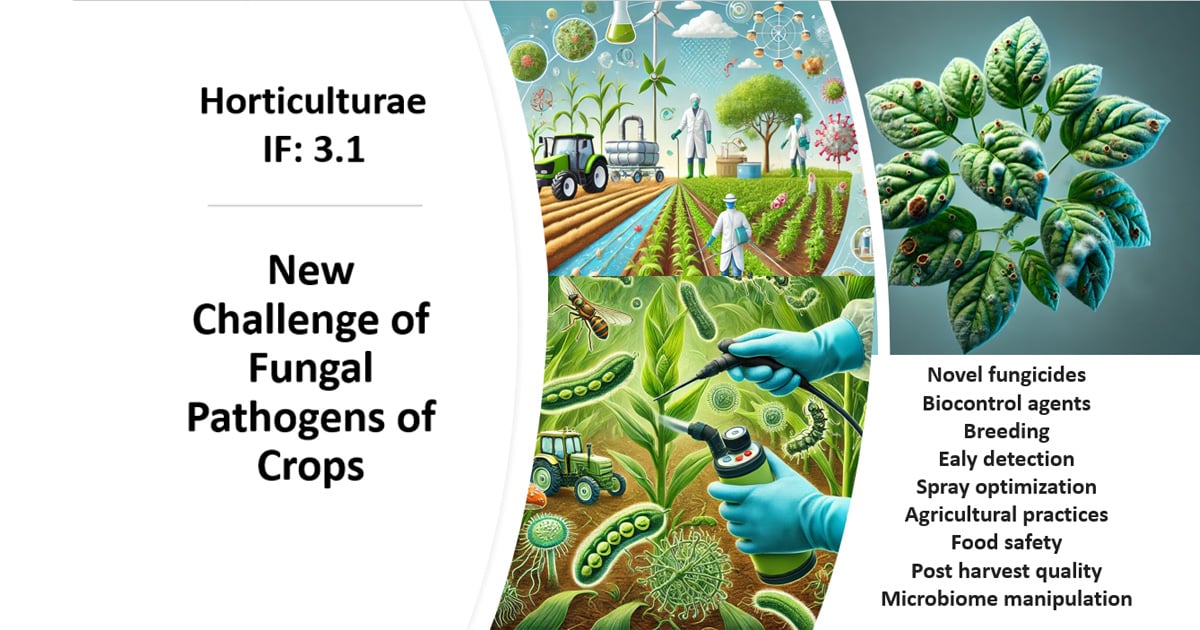New Challenge of Fungal Pathogens of Horticultural Crops
A special issue of Horticulturae (ISSN 2311-7524). This special issue belongs to the section "Plant Pathology and Disease Management (PPDM)".
Deadline for manuscript submissions: closed (20 December 2024) | Viewed by 2059

Special Issue Editors
Interests: fungi; kiwifruit vine decline syndrome; crop production; bacteria; bio stimulants; microbiome
Special Issues, Collections and Topics in MDPI journals
Interests: microbiota; pathobiome; actinidia; grapevine; plant disease; resistance; bioinformatics
Special Issues, Collections and Topics in MDPI journals
Special Issue Information
Dear Colleagues,
Horticultural crop production faces an escalating challenge from fungal pathogens, posing significant threats to both yield quantity and quality. The intensification of these challenges is propelled by various factors, including climate change-induced alterations in temperature and precipitation patterns, evolving pathogen strains, and globalization facilitating the spread of invasive species. The objective of this Special Issue is to showcase pioneering research, strategies, and technologies that have emerged and may be used to combat these adversities. Key areas of focus include disease surveillance and early detection methods that leverage advanced molecular tools, novel fungicides and biocontrol agents, precision application techniques that optimize efficacy while minimizing environmental impact, and integrated disease management strategies that synergistically combine cultural, biological, and chemical control measures. Furthermore, this Special Issue aims to shed light on emerging fungal pathogens and their interactions with horticultural crops, elucidating the underlying mechanisms of pathogenesis and host resistance. Research exploring the manipulation of plant microbiomes to enhance disease resilience and the development of resilient crop varieties through breeding or genetic engineering will also be highlighted. Additionally, the role of cultural practices—such as crop rotation, sanitation, and irrigation management—in mitigating the proliferation of pathogens will be explored in depth. Contributions addressing the impact of fungal diseases on the post-harvest quality, food safety, and marketability of horticultural commodities are encouraged. This includes investigations into the persistence of mycotoxins, allergens, and other contaminants in harvested produce, as well as the development of post-harvest treatments for mitigating spoilage and extending shelf life.
Dr. Francesco Spinelli
Dr. Giovanni Mian
Guest Editors
Manuscript Submission Information
Manuscripts should be submitted online at www.mdpi.com by registering and logging in to this website. Once you are registered, click here to go to the submission form. Manuscripts can be submitted until the deadline. All submissions that pass pre-check are peer-reviewed. Accepted papers will be published continuously in the journal (as soon as accepted) and will be listed together on the special issue website. Research articles, review articles as well as short communications are invited. For planned papers, a title and short abstract (about 100 words) can be sent to the Editorial Office for announcement on this website.
Submitted manuscripts should not have been published previously, nor be under consideration for publication elsewhere (except conference proceedings papers). All manuscripts are thoroughly refereed through a single-blind peer-review process. A guide for authors and other relevant information for submission of manuscripts is available on the Instructions for Authors page. Horticulturae is an international peer-reviewed open access monthly journal published by MDPI.
Please visit the Instructions for Authors page before submitting a manuscript. The Article Processing Charge (APC) for publication in this open access journal is 2200 CHF (Swiss Francs). Submitted papers should be well formatted and use good English. Authors may use MDPI's English editing service prior to publication or during author revisions.
Keywords
- metabarcoding
- emergent threats
- sustainability
- plant resilience
- pathobiomes
- bio control
Benefits of Publishing in a Special Issue
- Ease of navigation: Grouping papers by topic helps scholars navigate broad scope journals more efficiently.
- Greater discoverability: Special Issues support the reach and impact of scientific research. Articles in Special Issues are more discoverable and cited more frequently.
- Expansion of research network: Special Issues facilitate connections among authors, fostering scientific collaborations.
- External promotion: Articles in Special Issues are often promoted through the journal's social media, increasing their visibility.
- e-Book format: Special Issues with more than 10 articles can be published as dedicated e-books, ensuring wide and rapid dissemination.
Further information on MDPI's Special Issue policies can be found here.






